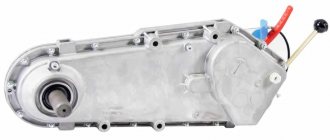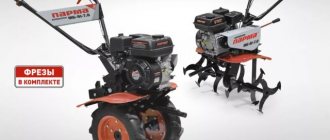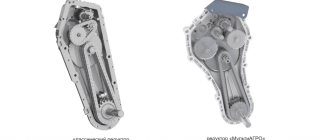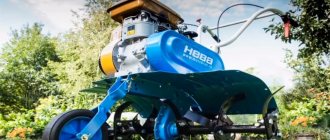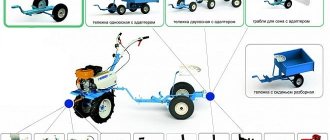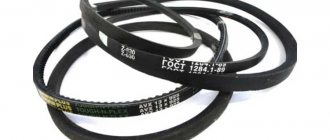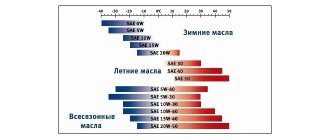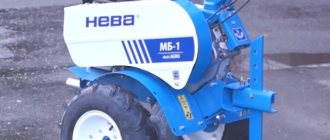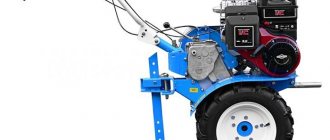Neva MB-2 walk-behind tractors are gaining great popularity among farmers, summer residents and gardeners - small agricultural equipment designed for cultivating various types of soil, from light and loamy soil in personal plots to virgin soil with rocky inclusions. When equipped with mounted and trailed mechanisms, the unit can perform the following work:
- milling, loosening and leveling the soil;
- harrowing and cultivation;
- hilling and digging up root crops;
- watering, spraying, pumping water;
- crushing and mixing feed and fertilizers;
- transportation of goods over short distances;
- cleaning the area from debris and snow;
- drilling the soil.
Agricultural equipment is produced by the St. Petersburg machine-building state enterprise "Red October". The company's activities are aimed at the mass production of multi-speed walk-behind tractors and walk-behind cultivators with domestic and imported engines from leading foreign companies Subaru, Honda, Briggs & Stratton and the modernization of attachments, which can increase productivity, facilitate the physical work of people and create maximum comfort when using the unit.
Purpose
The main task for which the Neva MB 2 walk-behind tractor is designed is the processing of different types of soils, including heavy virgin soils. They can be used even in winter (but only if SAE 10W20 series oil is used to service the mechanisms). Using such units, you can perform a huge number of agricultural tasks, including:
- plowing;
- harvesting;
- planting potatoes (and other crops);
- cultivation;
- weeding (in the area between rows);
- hilling;
- mowing grass;
- pumping water;
- cleaning the area and transporting goods.
The given list of manipulations is available to such devices thanks to attachments, presented in various variations.
Motoblock Neva MB 2
How much oil is required for a walk-behind tractor engine?
Before independently pouring new oil into a walk-behind tractor, the owner of the agricultural machinery must find out how much liquid is already in the internal combustion engine. It is quite possible that at the moment a complete replacement of the existing lubricant is not required, and instead you can simply add the missing amount of technical fluid.
To independently check the level of contents in the oil tank, you need to:
- Unscrew the plug of the standard filler hole provided in the crankcase of the utility walk-behind tractor;
- Insert the oil dipstick into the factory engine crankcase through the hole provided by the manufacturer, pull it out and check the oil level;
- There are special marks on the built-in probe; as a rule, they are represented by the “MIN” and “MAX” markings. After removing the dipstick, you need to look at what mark the oil stain is located. It should be located midway between these marks. If the liquid level is below o, then you will need to add lubricant;
- If the probe used does not have factory marks, the operator will have to navigate along the length of the device. After measuring the volume of liquid, its volume should reach the middle of the dipstick;
- In some cases, the operator may not have a dipstick. In this case, the amount of lubricant can be checked visually. To do this, you need to look through the filler neck - if the liquid level reaches almost to the neck, then the owner does not need to add engine oil for the walk-behind tractor.
After independently checking the level of the existing lubricant, you need to close the standard filler cap as tightly as possible and make sure that the liquid does not leak out.
Specifications
Among the significant parameters of the mechanism are:
- working area coverage – 1.2 m;
- fuel container size – 3.6 l;
- fuel consumption - 1-1.6 l/hour;
- soil tillage depth – 0.2 m;
- operating speed (during cultivation) – 12 cells/hour;
- travel speed – 12 km/h;
- operational weight – 2 quintals;
- maintaining stability at an angle of inclination of 15˚.
Dimensional characteristics of the Neva MB 2 walk-behind tractor:
- DShV – 1.74x0.65x1.3 m;
- standard gauge length – 0.32 m;
- ground clearance – 0.14 m;
- the smallest turning radius is 1.1 m.
The mechanism is equipped with a four-stroke single-cylinder engine with a manual starter. All components are cooled using a special air system. The operation of the equipment is ensured by the rotation of the gearbox transmitted by a three-groove pulley.
Motoblock Neva MB 2 with cutter
Engine
One of the features of the MB2 line units is the existence of a number of modifications equipped with different engines:
- MB 2K has an inexpensive but durable domestic motor. The valves are located on top, the crankshaft is horizontal. Has a power of 6.5 horsepower.
- the MB 2B (which is a mini-tractor) has an imported engine from the manufacturers Briggs& and Stratton (5.5 hp).
- MB 2C has an EX RobinSubaru engine (6.5 hp).
Be sure to read: Caterpillars for walk-behind tractors
The engine of the Neva MB 2 walk-behind tractor determines what volume of work or size of land plot the unit can handle in the future, but any of the devices can process 10-15 acres without any problems. If you need to cultivate a large area, it is better to select a modification with a power of 9 liters. With.
Operating instructions for walk-behind tractors Neva MB-2
According to the operating instructions, before turning on the walk-behind tractor, it is necessary to carry out preparatory work:
- check all components and fastening connections for tightness and reliability;
- familiarize yourself with the safety measures described in the manual;
- check the engine oil level;
- fill the fuel tank with pure gasoline AI-95 or AI-92;
- re-preserve the walk-behind tractor;
- check the presence of oil in the gearbox;
- inspect the tires.
Run-in
Running in is an important stage in the operation of any equipment. If the process is carried out incorrectly and the walk-behind tractor is not properly maintained, its service life is reduced and the mechanisms become faulty.
Running in is carried out in light mode for 30 hours to grind in all parts.
The depth of soil cultivation reaches no more than 10 cm. Experts recommend carrying out this process without loads.
After break-in, you must perform the following steps:
- make the first oil change;
- check the strength of fastening connections;
- adjust the belt for the walk-behind tractor;
- check the operation of the left wheel release;
- remove additional restrictive gaskets between the carburetor outlet flange and the pipe flange.
Cultivation
When operating a walk-behind tractor with a cultivator, you must adhere to the following algorithm:
- Place the equipment in a horizontal position and check the steering.
- Adjust the tillage limiter to the desired depth.
- Carry out cultivation with the carburetor throttle valve half closed.
- When working in low temperatures, if the walk-behind tractor does not start, use the following method:
- keep the equipment for about 10 hours in a warm room, then quickly turn it on;
- Fill the engine with oil with a temperature of + 50…60°C;
- warm up the carburetor pipe and the system itself by placing a rag soaked in hot water on them.
Device
The design of the mechanism contains the following components:
- Gear chain reducer. Surrounded by a special metal case made of aluminum alloy. Designed for changing speeds (4 forward and 2 reverse gears).
- Motor complete with starter.
- Support frame. Equipped with elements that can be used to install hanging structures.
- Steering.
- V-belt transmission.
In general, the compactness and weight of the mechanism allow it to be transported to its destination even in a passenger car.
Oil in the gearbox of a walk-behind tractor - self-replacement
The standard gearbox of any walk-behind tractor needs lubrication no less than its factory engine. The gearbox is initially a complex structure consisting of several gears responsible for transmitting force from the engine to the working parts of agricultural machinery. During operation of the gearbox, the gears are constantly in contact with each other, which leads to the gradual wear of their teeth. To slow down this process, you need to use high-quality lubricant.
You can check the level of lubricant contained in the gearbox at a certain point in time as follows:
- Clean a 70-centimeter piece of wire that will serve as a probe;
- Bend a homemade probe into an arc;
- Insert the wire through the filler hole in the gearbox all the way and pull it out.
If the oil spot is located at a distance of 30 cm from the bottom edge of the dipstick, then there is no need to add oil. Otherwise, the operator must add the missing amount of liquid.
It is necessary to change the lubricant in a cold walk-behind tractor gearbox only if it has been discovered that it has turned a dark, almost black color. Another indicator of the need for urgent replacement is the presence of a large number of foreign inclusions and solid fractions in the lubricant.
What can be included with
In addition to the basic set, Neva MB 2 has additional equipment - mounted or trailed. There are more than two dozen such auxiliary elements. The standard walk-behind tractor kit includes:
- cultivator cutters – 4 pcs.;
- transport wheels – 2 pcs.;
- axial extensions.
The list of additional equipment includes:
- plow;
- walk-behind-front type rake;
- lugs;
- pump;
- snow blower, etc.
The full list of equipment is quite long, which allows you to use the Neva 2 walk-behind tractor in many directions.
Assembly
In practice, it is noted that the walk-behind tractor is sold assembled, but after purchase the owner may be faced with the issue of making adjustments to components and assemblies. This makes it possible to prepare the machine for work, making maximum use of all its characteristics, depending on operating conditions. The main point when carrying out such activities is the adjustment of the engine and fuel supply system.
The pressure of gasoline entering the engine through the carburetor is regulated using a tongue device, which is pressed or pressed depending on the amount of fuel entering the carburetor. A lack of fuel can be determined by the white smoke coming out of the exhaust pipe. Excessive amount of fuel in the combustion chamber is the reason why the engine “sneezes” during operation or does not start at all. Fuel adjustment makes it possible to adjust the normal operation of the unit depending on the needs in combination with engine power. To carry out more serious repairs, it may be necessary to assemble and disassemble the carburetor, cleaning the jets and channels inside.
In order for the engine to run smoothly, it needs to have its valve system adjusted. For this purpose, the unit comes with instructions for carrying out the work, as well as the correctness and sequence of their implementation.
Before starting operation, it is necessary to clean all elements, tighten bolts and components.
installation
The time has come to install the plow on the walk-behind tractor. Ale for the cob on the new one, it is necessary to secure the mixture:
- The necessary tools for carrying out the operation are laid out: keys, a key, a plow.
- The furrow depth is regulated. The opening of the mat and the plow stand is exposed.
- The openings are secured with a hammer bolt.
- The clamp is installed on the plow and is fixed with bolted connections.
- The structure is hung on a walk-behind tractor.
werewolf plow
This type of equipment is manufactured from special structural steel, which results in a high level of attention to detail.
When plowing with a single-hull plow, the soil is thrown more to one side. So, to plant the advancing rows, he needs to turn all the time to the ear of the furrow. When cultivating the soil with a reversible plow at the end of the skin furrow, you just need to light up the blade and continue to turn the furrow.
With two different straight blades, you can cut the orange in both directions. Moreover, to change directly you just need to press the pedal, the fixing stand, and open the blade 90˚. This design can also be successfully used for harvesting potatoes and other root crops.
Wheel lugs
Lugs are a modified group of wheels that do not have tires or tubes.
The main purpose is to carry out work in the fields (the key value is adhesion to the soil).
They mean steel wheels with special external inserts that provide significant assistance when moving.
Kum 680 wheels for hilling
A distinctive feature is the presence of:
- solid rim;
- the spikes protrude 7 cm.
Wheel sizes of the Neva walk-behind tractor of this modification:
- diameter along the spikes – 43 cm;
- rim diameter – 35 cm.
The width of the lug is 20 cm.
The total weight of the structure is 16.5 kg.
Installation is carried out on the gearbox shaft - no additional connections are provided.
Universal wheels Kum 540 for hilling
A distinctive feature from the 680 model is not a solid rim, but the presence of only a side - it is full inside. In addition, the spikes do not have an inclination to one side, but have a V-shape.
When moving into the ground, traction with the ground is provided not only by the studs, but also by the rim itself, due to which the maximum effect is achieved.
Diameter is:
- along external spines - 54 cm;
- along the rim – 46 cm.
- width – 9 cm.
Important! For installation, it is additionally necessary to purchase an extension cord, since the standard version does not provide any fasteners - only holes with a diameter of up to 65 cm.
Universal wheels Kum 540 with long hub
KUM 540 is often used for hilling, but the bushing is already installed - it is connected directly to the gearbox shaft.
An additional distinctive feature is the width of the stake, which can reach 68 cm.
Main characteristics:
- number of hoops – 2 pcs.;
- diameter along the wheel at the studs – 540 mm, at the hoop – 460 mm. Spike width – 90 mm;
- The bushing diameter is 30 mm.
Installation is carried out on the gearbox shaft. The total weight does not exceed 13.5 kg.
H lugs for plowing
Features include large diameter and width. They are used when it is necessary to work with virgin soil or plots after winter inactivity, when the surface is still hard and requires preparation.
Characteristic:
- width – 20 cm;
- diameter along the spikes - 43 cm, along the hoop - 35;
- spike height – 8 cm.
Provide the best cross-country ability for your equipment.
Installation is possible on the shaft of the Neva walk-behind tractor or on extensions - depending on the specific situation.
In the case of direct installation, the track width will be 40 cm; when using an extension, it will vary from 65 to 70 cm.
Mini H lugs for plowing
The lugs for Neva cultivators are similar to the KUM model range.
Main characteristics:
- wheel diameter – 32 cm;
- width – 16 cm;
- pair weight – 8 kg.
The best option for plowing soil.
H lugs for plowing with long sleeve
Full identity with the considered model range. The only difference is the presence of an already mounted bushing.
In this modification, the track size is fixed - 65 cm.
Mini H lugs for hilling
Today they are considered one of the lightweight MINI N models for plowing. During hilling, the soil is already prepared and not hard, which is why there is no need for a massive type.
The diameter of the hoop is set to 28 cm, and the width for hilling is 9 cm.
Weight does not exceed 4.85 kg.
Designed for use in summer and winter.
